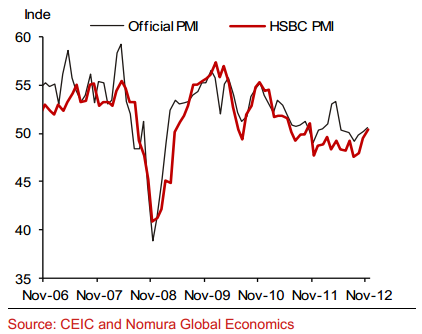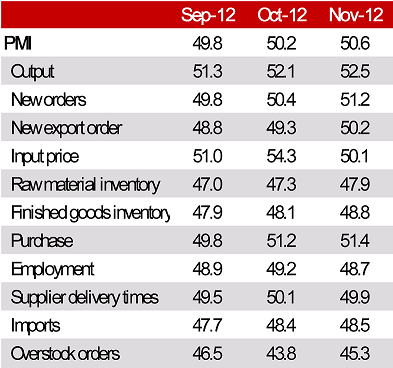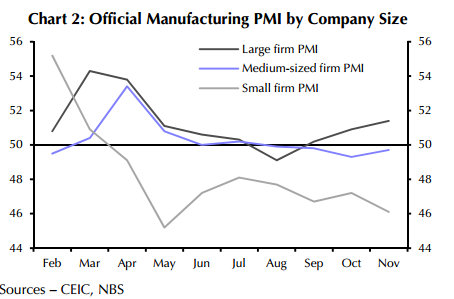Cross-posted from FTAlphaville.
November marked the first time in over a year that both the official China manufacturing PMIs and the HSBC/Markit Economics PMIs were above 50.
And they are both nearly matching! Check it out:

The official number was 50.6; HSBC’s was 50.5 (up from the flash preliminary number of 50.4).
Looks undeniably positive for China’s economic growth.
Except… we still have some concerns. The PMIs aren’t yet painting a convincing picture of a recovery that is sustainable beyond the short-term.
Let’s start with the HSBC/Markit figures, which we wrote about after the flash release earlier in November. As Capital Economics’ Mark Williams writes on Monday, the final figures haven’t changed much since:
Small revisions to the PMI components don’t change the general picture from the flash release: while output was strong (up from October’s 48.2 to 51.3, unchanged from the flash), more forward-looking indicators were less encouraging than in October. Finished goods inventory edged up from 48.4 to 48.8 (flash 49.5), signalling that inventories are being run down at a slower rate. New orders weakened from 51.2 to 50.8 (flash 50.1)
So the ‘new orders’ are not as bad as in the flash, and still on the right side of 50 — but they are down quite a bit from October. This is not helping the drawing down of inventories, which had built up to problematic levels around the middle of this year, but were beginning to abate in the past few months. This point was also made by Societe Generale’s Wei Yao, with regard to the official November PMIs:
Input inventories remained in contraction with the latest reading of 47.9 (vs. 47.3 in October), while finished goods inventories were run down at a slower pace (48.8) than in the previous two months (48.1 in October and 47.9 in September).
Perhaps worse though, is the absence of any sign of improvement in employment manufacturing. This is from the official PMIs:

This might simply reflect an evolution of China’s labour market, perhaps encompassing the advance of automation, albeit one that could be risky for stability. It might also be related to the fact that the smaller businesses are faring the worst:

And the larger firms, which tend to be the state-owned firms, have a disproportionately large share of access to financing. Despite this, SMEs are both far more efficient and are bigger employers, relative to their share of GDP.
Who said China’s government is worried about employment? Actually, the Chinese government has said that — after all, SMEs are big employers. But the government’s pronouncements late last year that it would focus on helping SMEs by, for example, making credit access easier, does not seem to be working out.
As Capital Economics’ Williams writes, the relatively poor performance of small and medium businesses indicates a return of the same old growth strategy seen in recent years:
This fits that view that recovery is being driven by spending on infrastructure, which tends to benefit large industrial firms.

